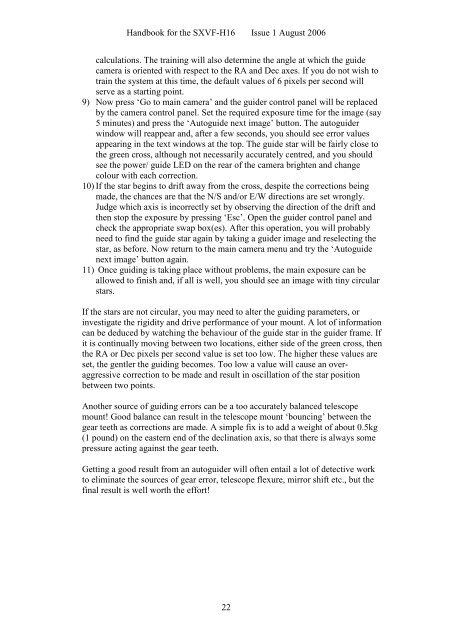SXVF-H16 handbook.pdf - Starlight Xpress
SXVF-H16 handbook.pdf - Starlight Xpress
SXVF-H16 handbook.pdf - Starlight Xpress
You also want an ePaper? Increase the reach of your titles
YUMPU automatically turns print PDFs into web optimized ePapers that Google loves.
Handbook for the <strong>SXVF</strong>-<strong>H16</strong> Issue 1 August 2006<br />
calculations. The training will also determine the angle at which the guide<br />
camera is oriented with respect to the RA and Dec axes. If you do not wish to<br />
train the system at this time, the default values of 6 pixels per second will<br />
serve as a starting point.<br />
9) Now press ‘Go to main camera’ and the guider control panel will be replaced<br />
by the camera control panel. Set the required exposure time for the image (say<br />
5 minutes) and press the ‘Autoguide next image’ button. The autoguider<br />
window will reappear and, after a few seconds, you should see error values<br />
appearing in the text windows at the top. The guide star will be fairly close to<br />
the green cross, although not necessarily accurately centred, and you should<br />
see the power/ guide LED on the rear of the camera brighten and change<br />
colour with each correction.<br />
10) If the star begins to drift away from the cross, despite the corrections being<br />
made, the chances are that the N/S and/or E/W directions are set wrongly.<br />
Judge which axis is incorrectly set by observing the direction of the drift and<br />
then stop the exposure by pressing ‘Esc’. Open the guider control panel and<br />
check the appropriate swap box(es). After this operation, you will probably<br />
need to find the guide star again by taking a guider image and reselecting the<br />
star, as before. Now return to the main camera menu and try the ‘Autoguide<br />
next image’ button again.<br />
11) Once guiding is taking place without problems, the main exposure can be<br />
allowed to finish and, if all is well, you should see an image with tiny circular<br />
stars.<br />
If the stars are not circular, you may need to alter the guiding parameters, or<br />
investigate the rigidity and drive performance of your mount. A lot of information<br />
can be deduced by watching the behaviour of the guide star in the guider frame. If<br />
it is continually moving between two locations, either side of the green cross, then<br />
the RA or Dec pixels per second value is set too low. The higher these values are<br />
set, the gentler the guiding becomes. Too low a value will cause an overaggressive<br />
correction to be made and result in oscillation of the star position<br />
between two points.<br />
Another source of guiding errors can be a too accurately balanced telescope<br />
mount! Good balance can result in the telescope mount ‘bouncing’ between the<br />
gear teeth as corrections are made. A simple fix is to add a weight of about 0.5kg<br />
(1 pound) on the eastern end of the declination axis, so that there is always some<br />
pressure acting against the gear teeth.<br />
Getting a good result from an autoguider will often entail a lot of detective work<br />
to eliminate the sources of gear error, telescope flexure, mirror shift etc., but the<br />
final result is well worth the effort!<br />
22
















